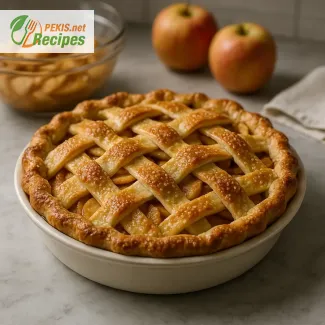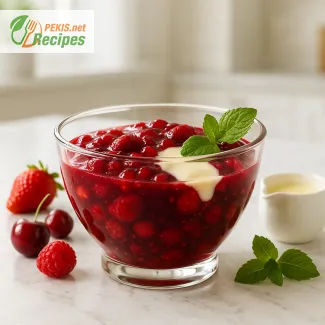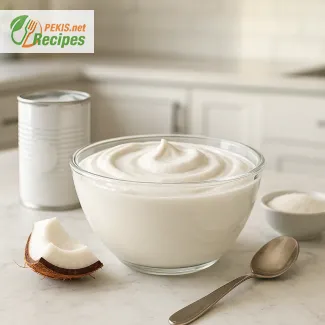
Homemade Perfection: The Secret Behind a Flaky, Flavorful Apple Pie
Why the art of baking apple pie never goes out of style
A classic apple pie recipe from scratch is far more than just a dessert—it’s an emotional experience. Rooted in tradition and perfected over generations, this beloved dish evokes nostalgia, warmth, and comfort in every bite. When done right, the balance of tender apples, aromatic spices, and golden flaky crust transforms simple ingredients into something extraordinary. Whether it’s the star of a holiday feast or the centerpiece of a Sunday gathering, a well-crafted apple pie embodies the essence of home-baked excellence.
What sets this timeless dessert apart is the attention to every element. From choosing the right apple varieties to crafting the perfect buttery crust, each step contributes to a pie that’s rich in flavor, texture, and authenticity. A true homemade apple pie doesn’t rely on shortcuts or pre-made fillings; instead, it celebrates the simplicity and integrity of real ingredients. This commitment to tradition is what elevates a standard pie into a memorable, crowd-pleasing masterpiece.
The role of apples: Choosing the ideal mix for depth of flavor
Not all apples are created equal when it comes to baking. The key to a successful apple pie lies in the selection of firm, tart-sweet apples that can hold their structure during baking without turning mushy. Granny Smith apples are widely favored for their bright acidity and ability to contrast beautifully with sugar and spices. However, blending varieties—such as Honeycrisp for sweetness and Braeburn or Jonagold for body—adds complexity and depth to the filling.
The goal is to achieve a balance: tartness to cut through the sweetness, a juicy bite that isn’t watery, and a soft-yet-structured texture that doesn’t disintegrate during baking. A well-balanced filling enhances every bite with layers of taste and a pleasing mouthfeel. It’s this harmony that makes a homemade apple pie more than just a pastry—it becomes a culinary statement.
Building the perfect crust: Flaky, golden and crisp
A great pie starts with a perfect homemade crust. There’s a delicate balance between richness and structure, and achieving that flaky texture depends on cold butter, minimal handling, and precise timing. Unlike store-bought options, a from-scratch crust offers a superior flavor and texture that complements the filling rather than overpowering it.
The secret lies in the science: when cold butter is cut into the flour and baked, it creates steam pockets that result in flaky layers. Ice water helps bind the dough without overworking the gluten, keeping it tender. Chilling the dough before rolling it out ensures it stays firm and workable. A perfectly made crust is golden, crisp, and subtly buttery—providing the ideal contrast to the warm, cinnamon-kissed apple interior.
Spices and sweetness: The role of seasoning in apple pie
Cinnamon may be the hero, but it’s not alone. A great apple pie benefits from a curated blend of warming spices like nutmeg, allspice, and a touch of clove. These spices intensify the natural flavors of the apples, enhancing both aroma and taste. Too much of any one spice, however, can overwhelm the delicate balance—so restraint and proportion are essential.
As for sweeteners, brown sugar adds depth and a slight molasses note, while white sugar provides a cleaner sweetness. Some bakers incorporate a spoonful of maple syrup or honey to introduce a floral complexity. The result is a rich, layered flavor profile that evolves with each bite, keeping the palate engaged.
Texture matters: From filling to finish
Texture is as important as flavor. Overcooked apples can turn mealy, while undercooked slices remain too firm. The ideal filling has apples that are tender with a slight bite, suspended in a light syrup thickened by cornstarch or flour. Venting the top crust and baking at the right temperature allows steam to escape, preventing soggy bottoms and ensuring the filling reduces just enough without becoming runny.
A finishing touch such as an egg wash gives the top crust a glossy sheen, while a sprinkle of coarse sugar adds a delicate crunch. Every element contributes to the overall textural experience—from the crisp edge of the crust to the soft spiced interior.
Serving suggestions and seasonal appeal
While apple pie is often associated with autumn, its appeal spans the seasons. Served warm with a scoop of vanilla ice cream, it becomes an indulgent winter treat. During summer, a slice of chilled apple pie with whipped cream feels just as appropriate. Its versatility and timelessness make it one of the few desserts that resonate with all ages, across all occasions.
A homemade apple pie is more than a dessert—it’s a personal expression of care and craftsmanship. From farm-fresh apples to the final slice, this recipe invites you to reconnect with the essence of slow baking and to rediscover why this iconic dish holds a permanent place in the world of comfort food.
1. Prepare the pie dough:
In a large bowl, combine all-purpose flour, salt, and granulated sugar. Add cold, diced butter and cut it into the flour using a pastry blender or fingertips until the mixture resembles coarse crumbs. Gradually add ice water, one tablespoon at a time, mixing until the dough comes together without being sticky. Divide into two equal discs, wrap in plastic, and chill in the refrigerator for at least 60 minutes.
2. Prepare the apple filling:
Place the sliced apples in a large bowl. Drizzle with lemon juice and toss to coat evenly. Add brown sugar, cinnamon, nutmeg, allspice, and cornstarch. Mix well until apples are thoroughly coated and set aside to macerate for 15 minutes.
3. Roll out the dough:
On a floured surface, roll out one dough disc into a circle about 30 cm (12 inch) in diameter. Transfer it to a 23 cm (9 inch) pie dish, gently pressing into the corners. Trim excess dough. Pour the apple filling into the crust, mounding slightly in the center and spreading evenly.
4. Add the top crust:
Roll out the second dough disc to the same size. Place over the apples, trim any excess, and crimp the edges to seal. Cut a few small slits in the top crust for steam to escape.
5. Apply egg wash and sugar:
Beat the egg with milk and brush it over the top crust. Sprinkle with coarse sugar for added crunch and shine.
6. Bake the pie:
Preheat oven to 200°C (400°F). Place the pie on the lower oven rack and bake for 20 minutes. Reduce temperature to 180°C (350°F) and continue baking for another 40 minutes or until the crust is golden and the filling is bubbling. If edges brown too quickly, cover them with foil.
7. Cool and serve:
Allow the pie to cool for at least 2 hours before slicing. This ensures the filling sets properly.
Creative Twists to Elevate Your Homemade Apple Pie
Expert tips to customize flavor, texture, and health without losing tradition
Even the most beloved classic apple pie can be transformed into something even more remarkable with a few strategic adjustments. Home baking gives you full control over every ingredient and process, opening the door to flavor enhancements, dietary adaptations, and texture refinements. Whether you're looking to reduce sugar, boost nutrition, or simply introduce a signature twist, these expert tips will help you reimagine a timeless dessert without compromising its comforting charm.
Enhance the flavor with spice variations and natural sweeteners
While cinnamon, nutmeg, and allspice are the standard trio in most traditional apple pie recipes, adding a hint of cardamom or ginger can elevate the spice profile to something more aromatic and exotic. These additions offer a subtle warmth and complexity that pair beautifully with apples, especially in cooler months.
For a deeper, more caramel-like flavor, consider swapping out some or all of the white sugar for maple syrup or coconut sugar. These natural sweeteners not only lower the glycemic index but also add nuanced layers of sweetness. A dash of vanilla extract or orange zest can also introduce a fragrant top note that brightens the entire filling.
Upgrade your crust with alternative fats and flours
The traditional butter crust is rich and flavorful, but if you're seeking a slightly healthier or dairy-free version, try using refined coconut oil or plant-based margarine. These fats still create a flaky texture but introduce different subtle flavors—coconut oil adds a mild tropical undertone, while vegan butters maintain a neutral taste.
For a more nutrient-dense crust, replace a portion of the all-purpose flour with whole wheat pastry flour or spelt flour. These alternatives increase fiber and minerals, resulting in a slightly earthier flavor and more wholesome bite. Just be mindful of the flour ratios to maintain tenderness.
Choose your apples wisely—or roast them first
Using a blend of tart and sweet apple varieties adds complexity. If you want to intensify flavor even further, consider roasting the apple slices with spices before adding them to the crust. This method concentrates their natural sugars, draws out moisture, and prevents a soggy base. It also deepens the filling's color and flavor, giving the pie a rich, almost buttery finish.
Apples like Pink Lady, Fuji, or Cortland are excellent in combination with Granny Smith for a fuller flavor spectrum. Avoid apples that break down too easily, like Red Delicious, which can create a mushy texture.
Reduce sugar without sacrificing flavor
To lighten the sugar content while keeping flavor intact, focus on the sweetness of your apples and enhance it with cinnamon and citrus zest rather than more sugar. Natural fruit sweetness is often enough, especially when using ripe apples and a pinch of salt to heighten their natural profile.
A small amount of lemon juice not only prevents browning but balances sweetness with acidity. This balance is key to creating a well-rounded taste.
Common mistakes to avoid in homemade apple pie
One of the most frequent errors is overfilling the pie. Piling in too many apple slices may seem generous but can lead to undercooked centers or cracked crusts. Keep the filling evenly distributed and slightly mounded.
Another mistake is using wet apples. Failing to drain apples after maceration results in a watery filling and soggy bottom. Let them sit, then strain excess liquid before layering into the crust.
Crust problems also abound: overworking the dough develops gluten, making it tough, while underbaking results in a pale, doughy finish. Always chill the dough and ensure full baking time—look for a deeply golden color as your cue.
Make it more wholesome with smart substitutions
Health-conscious bakers can incorporate rolled oats into the top crust for a rustic, streusel-style finish. This works well with a touch of almond flour or chopped nuts for added crunch and protein. Replacing butter with avocado or a mix of nut butters can also increase healthy fats.
Adding chia seeds or ground flaxseeds to the filling not only thickens the mixture but also boosts fiber and omega-3 content. For a gluten-free version, use a certified gluten-free flour mix and bind the dough with a small amount of psyllium husk or xanthan gum for elasticity.
Why homemade apple pie always wins
Compared to store-bought versions, homemade apple pie stands apart in texture, freshness, and ingredient integrity. You avoid preservatives, artificial flavors, and excess sugar, all while customizing every layer to your liking. The crust is flakier, the apples are more vibrant, and the spices are infinitely more fragrant.
Additionally, baking from scratch allows you to adjust for dietary preferences or seasonal produce. It becomes an act of creativity and connection—a dessert made with intention and care.
Adding new textures for contrast
If you want to add crunch to the soft filling, consider mixing in a handful of toasted walnuts or pecans. These not only enhance the mouthfeel but also bring a nutty richness that complements spiced apples perfectly.
For a luxurious twist, dot the filling with butter or a spoonful of cream cheese before sealing the crust. This creates pockets of creaminess that melt into the apples as they bake.
Finishing touches that impress
A simple egg wash creates shine, but brushing the crust with cream or milk and a sprinkle of turbinado sugar adds extra crunch and visual appeal. A drizzle of caramel sauce or a scoop of cinnamon ice cream served with each slice can turn a simple dessert into an unforgettable treat.
These adjustments don’t just enhance the pie—they tailor it to your unique taste, dietary needs, and creative instincts, all while preserving the comforting soul of a traditional apple pie.
Allergens present in the recipe:
- Gluten (wheat flour)
- Dairy (butter, milk)
- Eggs
Suggestions for allergen-free or gluten-free preparation:
- Replace all-purpose flour with a certified gluten-free flour blend containing xanthan gum.
- Use plant-based butter alternatives for a dairy-free version.
- Replace egg wash with a mix of plant milk and maple syrup for vegan/gluten-free baking.
Vitamins and minerals per serving (approximate):
- Vitamin C: 6 mg – Supports immune function and collagen production.
- Vitamin A: 90 µg – Essential for vision and cell growth.
- Potassium: 210 mg – Maintains proper heart and muscle function.
- Iron: 1.4 mg – Helps transport oxygen in the blood.
- Calcium: 30 mg – Contributes to bone health.
- Magnesium: 10 mg – Supports nerve and muscle function.
Antioxidants per serving (approximate):
- Quercetin: 8 mg – Found in apples, helps reduce inflammation and supports heart health.
- Chlorogenic acid: 12 mg – Aids in metabolic regulation and protects against oxidative stress.
- Cinnamaldehyde (from cinnamon): 4 mg – Known for its anti-inflammatory and antimicrobial properties.





